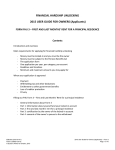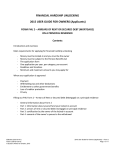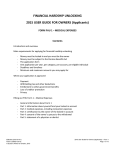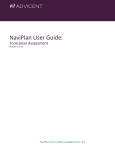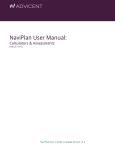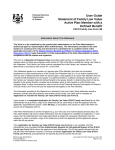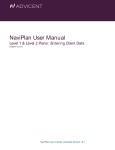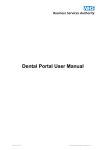Download Financial Hardship Unlocking - User Guide for Owners (Applicant)
Transcript
FINANCIAL HARDSHIP UNLOCKING USER GUIDE FOR OWNERS (Applicants) FORM FHU 4 – LOW EXPECTED INCOME Contents Introduction and overview Main requirements for applying for financial hardship unlocking - Money must be locked-in and you must be the owner Money must be subject to the Pension Benefits Act The application form One application per year, per category, per account Deadlines and timelines Minimum and maximum amounts you may apply for When your application is approved - Payment Withholding tax and other deductions Entitlement to other government benefits Loss of creditor protection Privacy Filling out FHU Form 4 – Low Expected Income - General information about Form 4 Part 1: Information about yourself and your locked-in account Part 2: Expected income Part 3: Certification by the owner of the locked-in account Part 4: Consent of the owner’s spouse to the withdrawal Effective (2014-01-16) FSCO (1299E-I) © Queen's Printer for Ontario, 2014 User Guide for Owners (Applicants) – Form 4 Page 1 of 12 INTRODUCTION AND OVERVIEW This User Guide is intended to assist owners of locked-in accounts who wish to apply to withdraw money from locked-in accounts because of financial hardship, in accordance with the requirements of Regulation 909, R.R.O. 1990, under the Ontario Pension Benefits Act. Please note that this User Guide is a guideline only. It is meant to provide guidance to individuals who are filling out applications. Where this guideline conflicts with the Financial Services Commission of Ontario Act, 1997, S.O. 1997, c. 28 (FSCO Act), the Pension Benefits Act R.S.O. 1990, c. P.8. or Regulation 909, R.R.O. 1990 (Regulation), the FSCO Act, Pension Benefits Act or Regulation govern. There are four categories of financial hardship: (i) medical expenses; (ii) arrears of rent or debt secured on a principal residence (such as a mortgage); (iii) payment of first and last months’ rent; and (iv) low expected income. This User Guide is only for category (iv): low expected income. If you want to make an application during this year under one of the other categories, you must make a separate application. For applications under other categories, please refer to the appropriate User Guide on the FSCO website. Effective January 1, 2014, all applications for financial hardship withdrawals must be made to the financial institution which holds and administers your locked-in account. A financial institution may be one of the following institutions: - bank - life insurance company - credit union - caisse populaire - trust company If you have invested the money in your locked-in account through a financial advisor, you should ask your advisor if you should make your application through him/her, or directly to the financial institution that holds your locked-in account. You cannot make your application to the Financial Services Commission of Ontario (FSCO). FSCO no longer has the authority to process these applications. Your financial institution is responsible for answering questions and providing information to you regarding your application. Effective (2014-01-16) FSCO (1299E-I) © Queen's Printer for Ontario, 2014 User Guide for Owners (Applicants) – Form 4 Page 2 of 12 MAIN REQUIREMENTS FOR APPLYING FOR FINANCIAL HARDSHIP UNLOCKING Money must be in a locked-in account and you must be the owner There are three different types of locked-in accounts: (i) Locked-in retirement accounts (LIRAs). (ii) Life income funds (LIFs). There are two kinds of LIFs: Old LIFs and “New LIFs”. (iii) Locked-in retirement funds (LRIFs). To apply for financial hardship withdrawal, your money must be in one of these accounts. If your money is still in your pension plan, you cannot apply to withdraw money on the basis of financial hardship. You must be the owner of the locked-in account to apply for financial hardship. The locked-in account must be in your name, not in your spouse’s name. If you are not sure whether you are the owner of the account, ask your financial institution or financial advisor. Money must be subject to the Pension Benefits Act The money in your locked-in account must be subject to Ontario pension law, not federal pension law or the pension law of another province. If the money is not subject to Ontario pension law, the financial institution must refuse your application. If you are not sure whether the money in your locked-in account is subject to Ontario pension law, ask your financial institution. The application form You must apply on the forms approved by the Superintendent of Financial Services. The application for low expected income must be made on Form FHU 4 for the year in which you are applying. Forms and other information about financial hardship unlocking may be accessed on FSCO’s website at: http://www.fsco.gov.on.ca/en/pensions/financial_hardship/Pages/fhu.aspx You may also contact FSCO and request an application form, or you may pick up an application form from FSCO’s office. You may also ask your financial institution for an application form. If an application is signed in 2014, the 2014 form must be used. You cannot use a previous year’s form. One application per year, per category, per account You may only make one application from your locked-in account each calendar year under the low expected income category. Effective (2014-01-16) FSCO (1299E-I) © Queen's Printer for Ontario, 2014 User Guide for Owners (Applicants) – Form 4 Page 3 of 12 The key date is the date your financial institution receives your complete application, along with any required accompanying documents. This could be the date the completed application is submitted in person, or the date it is received by mail, fax or electronically. Deadlines and timelines There are a number of important deadlines and timelines which must be met: (i) 60 day time limit for submitting the application Once you sign the application (and your spouse signs the consent, if applicable), you have 60 days to submit it to the financial institution. If you submit it after 60 days from the date you signed it, you will have to fill out another application. (ii) 30 day time limit for payment by financial institutions The financial institution must review the application and determine if it meets the requirements in the Regulation for the low expected income category of financial hardship. If the requirements are met, the financial institution must approve the application and make the payment within 30 days from the day it received the completed application. Minimum and maximum amounts you may apply for For all applications, the minimum amount you can apply for is $500.00. If you apply for less than $500.00, the application must be refused. The maximum amount for the low expected income category is described on page 8. You cannot apply for an amount greater than the maximum amount to which you are entitled; if you do apply for an amount greater than the maximum, the financial institution should advise you to amend the application. A financial institution is not permitted under the Regulation to pay an amount greater than the maximum the owner is entitled to. Please refer to the section below (Part 2, question 3) for more information about the maximum amount you may withdraw for low expected income. Effective (2014-01-16) FSCO (1299E-I) © Queen's Printer for Ontario, 2014 User Guide for Owners (Applicants) – Form 4 Page 4 of 12 WHEN YOUR APPLICATION IS APPROVED Payment The money must be paid in one lump sum. It cannot be paid monthly or in any other manner. It cannot be transferred to another tax-deferred account, such as a registered retirement savings plan or a registered retirement income fund. Withholding tax and other deductions The amount you are approved for will be reduced by an amount withheld for income tax. This is because when money is paid out of an unlocked account, financial institutions are required to withhold a certain amount of money for income tax and pay that amount to the Canada Revenue Agency (CRA). In addition, your financial institution may charge an administrative fee for your application, which will be deducted from the amount that was approved for you. For example, if you apply and are approved for a withdrawal of $20,000.00, the financial institution must withhold approximately 30 percent of that amount, which is $6,000.00, for income tax and pay it to CRA. If the financial institution charges you a $50.00 fee, that amount will also be deducted. Therefore, you will receive $13,950.00. If you want to receive a greater amount in cash than what you would have received after deductions, you should apply to withdraw a greater amount. But you cannot apply to withdraw an amount greater than the maximum to which you are entitled under the Regulation or greater than the amount in your account. Entitlement to other government benefits When you withdraw money from a locked-in account, that amount could be considered as income. This could affect your eligibility for benefits under a government program, such as social assistance. If you have a question as to whether this could apply to you, you should contact the government agency or department that administers the program or provides these benefits. Loss of creditor protection Money in locked-in accounts cannot be seized by creditors. However, if you withdraw money from a locked-in account for financial hardship, it will no longer be protected from creditors and may be seized. Effective (2014-01-16) FSCO (1299E-I) © Queen's Printer for Ontario, 2014 User Guide for Owners (Applicants) – Form 4 Page 5 of 12 Privacy The financial institution must advise each owner about the purpose for which personal information is collected, used or disclosed in accordance with any applicable law. FILLING OUT FHU FORM 4 – LOW EXPECTED INCOME General Information about Form 4 You may make one application under the low expected income category during a calendar year. If you have already applied under low expected income, you cannot apply again until the next calendar year. An application is considered to have been made in the year in which the financial institution receives the completed application. You may make more than one application for a withdrawal from the same locked-in account under different categories of financial hardship in the same year, but you must use different forms. Part 1 – Information about yourself and your locked-in account Question 1: Fill in the information about yourself in each box. Question 2: Fill in the name of the financial institution that holds your locked-in account (for example, the name of the bank, insurance company, credit union) and the number of the account. The only number in the box should be the number of the account from which you wish to withdraw money. Information about your spouse Question 3: If you have a spouse on the date you sign this application, fill in the information about your spouse in each box. “Spouse” is defined in the Pension Benefits Act as either of two persons who, (i) are married to each other; or (ii) are not married to each other and are living together in a conjugal relationship: a. continuously for a period of not less than three years; or b. in a relationship of some permanence, if they are the natural or adoptive parents of a child, both as defined in the Family Law Act. If you have a spouse and you are living separate and apart from your spouse due to a breakdown in your spousal relationship, your spouse is not required to consent to the withdrawal. However, you must still fill in the required information about your spouse in question 3. Effective (2014-01-16) FSCO (1299E-I) © Queen's Printer for Ontario, 2014 User Guide for Owners (Applicants) – Form 4 Page 6 of 12 Just because you and your spouse are living in different residences on the date the application is signed does not automatically mean you are not spouses for the purpose of this application. Your living separate and apart must be because there has been a breakdown in the spousal relationship. If one spouse is living elsewhere because of his/her work, or because he/she is looking after a relative or friend, or for health reasons, or for other reasons that are not related to their spousal relationship, it does not mean you are living separate and apart for the purpose of this application. It is possible that you may have “more than one spouse”. That is, you may be separated from your wife or husband although you are still married, but you may be living common law with another person who meets the definition of spouse in the Pension Benefits Act. In this case, you should fill in the information about the spouse with whom you are living when you apply – in this example, your common law spouse. The money can only be withdrawn if that person provides his or her consent (see Part 4). Part 2 – Expected Income Question 1: Other than this application, have you applied to withdraw money from this locked-in account based on low expected income at any time during 2014? If you answered yes, you cannot apply again under this category this year. Question 2: What is your expected total income from all sources before taxes for the 12 months following the date you sign this Application? This is an estimate of how much you expect to receive for the next 12 months, before taxes, starting on the date you sign the application. It is not based on the amount you have received in the past 12 months. If you do not expect to receive any income, you should enter zero. The following amounts should be included in determining your expected total income for the next 12 months: - - wages, salaries, casual earnings and amounts paid under a training program (gross amount, before taxes); income from self-employment (excluding expenses but before taxes); rental income (excluding expenses but before taxes); payments received under an annuity, pension plan, registered retirement savings plan, registered retirement income fund, superannuation scheme, or earnings replacement program; insurance benefits; spousal support payments; capital gains arising from the sale or disposition of an asset; cash payments received under a government program (except for those excluded below), such as Canada Pension Plan, Old Age Security, or Ontario Works; Effective (2014-01-16) FSCO (1299E-I) © Queen's Printer for Ontario, 2014 User Guide for Owners (Applicants) – Form 4 Page 7 of 12 - interest and dividend income on any investment; and income from any other source. All amounts entered into the form are before any deduction of taxes. Do not include any income your spouse expects to receive. Do not include the amount you expect to withdraw under this category if your application is approved. In addition, the following payments should not be included in your estimate: - a refund or repayment of taxes; a refundable tax credit; a refund of tax paid under the Ontario Child Care Supplement for Working Families program (under section 8.5 of the Income Tax Act); the payment to you of an Ontario child benefit (under section 8.6.2 of the Income Tax Act or under section 104 of the Taxation Act, 2007); a payment received by a foster parent under the Child and Family Services Act; or child support payments received under a court order or an agreement. Enter the total amount of expected income in box 2. In 2014, if the amount you enter in box 2 is greater than $35,000.00, your application must be refused. Question 3: What is the maximum amount you may withdraw? Your maximum is calculated by subtracting the amount in box 3b from the amount in box 3a. The amount in box 3a for 2014 is $26,250. In box 3b, fill in 75 percent of your expected total income for the next 12 months. This is 75 percent of the amount you entered in box 2. If your expected total income for the next 12 months is zero, fill in zero in box 3b. Subtract the amount in box 3b from the amount in box 3a and fill that amount in box 3c. This is the maximum amount that you may apply to withdraw under this category. Examples: Sue expects her income over the next 12 months to be $30,000.00 before taxes. Effective (2014-01-16) FSCO (1299E-I) © Queen's Printer for Ontario, 2014 User Guide for Owners (Applicants) – Form 4 Page 8 of 12 In box 2, she enters 30,000.00. In box 3b, Sue enters 75 percent of the amount she entered in box 2, which is 22,500.00. Box 3a (26,250.00) minus box 3b (22,500.00) equals 3,725.00, which Sue enters in box 3c. That is the maximum amount she can withdraw in 2014, based on her estimated expected income. Earl is unemployed and does not expect to receive any income over the next 12 months but he has applied for government assistance. He estimates that he will receive $10,000.00 in government assistance, so he enters 10,000.00 in box 2. 75 percent of that amount is 7,500.00, which is the amount he enters in box 3b. Box 3a (26,250.00) minus box 3b (7,500.00) equals 18,750.00, which Earl should enter in box 3c as his maximum. Lorraine has lost her job but expects to receive $40,000.00 from rental income, investments, government assistance, and spousal support. She enters 40,000.00 in box 2. Since that amount is greater than 35,000.00 (2/3 of the Year’s Maximum Pensionable Earnings for 2014), Lorraine’s application must be refused. Question 4: How much money are you applying to withdraw from this locked-in account? You do not have to apply for the maximum amount you are entitled to. In the examples above, Sue can decide to take the maximum, so she enters 3,725.00 in box 4. Earl decides he does not need the entire amount he is entitled to, so he enters 12,000.00 in box 4. You cannot apply for an amount that is: greater than the amount in your locked-in account as of the date you sign this application; greater than the maximum amount you are allowed to withdraw (box 3c); or less than $500.00. Remember that the amount you apply for will be reduced by withholding tax and may be reduced further by an administrative fee. Part 3 – Certification by the owner of the locked-in account Effective (2014-01-16) FSCO (1299E-I) © Queen's Printer for Ontario, 2014 User Guide for Owners (Applicants) – Form 4 Page 9 of 12 You must sign and date the certification in Part 3 in the presence of an adult witness, who must be 18 years of age or older. The witness cannot be your spouse or dependant. An employee of your financial institution may be a witness. Once the application is signed, you have 60 days to submit it to the financial institution. Certifications regarding spousal status You must certify certain information regarding your spousal status on the date you sign the application. In Part 3, you must check only one of four boxes: (i) You have a spouse and your spouse consents to the withdrawal of money from the locked-in account. (If you check this box, you will need your spouse to complete Part 4.) (ii) You have a spouse but you and your spouse are living separate and apart as a result of a breakdown in your spousal relationship. (iii) You have a spouse, but “none of the money in your locked-in account is derived, directly or indirectly, from a pension benefit provided in respect of your past or current employment”. This refers to a situation where you are seeking to withdraw money from a locked in account, and this money did not come from your pension but from someone else’s pension plan, such as your former spouse. For example, as a result of a divorce, John was required to pay a portion of his pension to Jane and the money was paid into Jane’s locked-in account. Jane subsequently married Bob and now wants to apply to withdraw money from her locked-in account for financial hardship. Since the money was earned by John, Jane’s current spouse Bob is not required to consent to the application. John is no longer Jane’s spouse, so his consent is no longer required. (iv) You do not have a spouse. Other certifications By signing the application, you are also certifying that: - all the information in the application and any accompanying documents is accurate and complete; - you have not previously applied to withdraw money for low expected income in this calendar year from this locked-in account; and Effective (2014-01-16) FSCO (1299E-I) © Queen's Printer for Ontario, 2014 User Guide for Owners (Applicants) – Form 4 Page 10 of 12 - the amount of your expected total income for the 12 months following the date you sign the application is accurate. Part 4 – Consent of the owner’s spouse to the withdrawal Your spouse must complete this part. If you have a spouse on the day you sign the certification, you may only withdraw money from your locked-in account if your spouse consents to the application. Your spouse’s consent is not required if: - you and your spouse are living separate and apart as a result of a breakdown in your spousal relationship; or - the money in your locked-in account came from the pension plan of another person, such as your former spouse. If your spouse wishes to consent, your spouse must fill in Part 4 and sign and date it in the presence of a witness who is at least 18 years of age. The witness must also sign Part 4. An employee of the financial institution may be the witness. The owner of the locked-in account cannot be the witness. If your spouse is not sure about the legal consequences of signing the consent, he or she should seek legal advice. Your spouse is under no obligation to sign. But if spousal consent is required and your spouse does not consent, the financial institution must refuse your application. Your spouse must indicate that he or she understands that: (i) the owner is making an application to withdraw money from the locked-in account, and that the owner cannot withdraw the money from the locked-in account without your spouse’s consent; (ii) as long as this money is in the locked-in account, your spouse may have a right to a share of this money if there is a breakdown in your spousal relationship or if you die; and (iii) if any money is withdrawn from the locked-in account, your spouse may lose any right that he or she has to a share of the money withdrawn. Effective (2014-01-16) FSCO (1299E-I) © Queen's Printer for Ontario, 2014 User Guide for Owners (Applicants) – Form 4 Page 11 of 12 If the financial institution is not satisfied that the spouse understands what he or she is signing, it may refuse the application. The financial institution may request proof of the spouse’s identity and spousal status. Effective (2014-01-16) FSCO (1299E-I) © Queen's Printer for Ontario, 2014 User Guide for Owners (Applicants) – Form 4 Page 12 of 12












